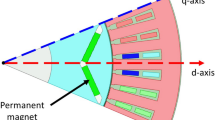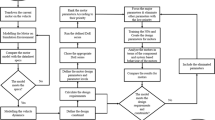Abstract
This paper is regarding to the design transformation methodology from induction motor (IM) to interior permanent magnet motor (IPM) to increase the efficiency of the traction motor and extend the range of the electric vehicle. Furthermore, the rotor structure of IPM is tried to be optimized without changing the stator and winding structure of the IM from the previous study to meet the vehicle requirements and maximize the motor efficiency in order to design the rotor structure of the IPM. Firstly, the design parameters, the vehicle requirements, and constraints are determined for the reference IM model. Secondly, the appropriate rotor geometry is chosen by considering the advantages and disadvantages of different rotor geometries for IPM. Then, the design parameters for the rotor are determined and investigated by using Taguchi's design of experiment (DoE) method considering the importance and priorities of the rotor design parameters of IPM. Thirdly, a neural network (NN) to predict better design parameters is trained to operate with the data of DoE according to the prioritization and normalization of framework. Finally, the reference IM and the predicted IPM models are evaluated in terms of the acceleration, the slope climbing, the driving performance (ECE R15), and battery consumption characteristics.










Similar content being viewed by others
References
Hruska K, Kindl V, Pechanek R (2017) Design of a high-speed permanent magnet synchronous motor for electric kart. Electr Eng 99:1141–1150. https://doi.org/10.1007/s00202-017-0623-2
Demir U, Aküner MC (2018) Design and analysis of radiaxial induction motor. Electr Eng 100:2361–2371. https://doi.org/10.1007/s00202-018-0708-6
Biltutanu A, Florea ML (2015) Modeling and testing of electric vehicle propulsion systems. UPB Sci Bull Ser C Electr Eng 77(3):201–212
Kwang HN (2010) AC motor control and electrical vehicle applications. Taylor & Francis, p 351
Kobelev A, Rozanov D, Makarov L (2020) Performance analysis of traction induction motors of various designs for low-floor light rail vehicles. In: XI international conference on electrical power drive systems (ICEPDS), St. Petersburg, Russia, pp 1–5, https://doi.org/10.1109/ICEPDS47235.2020.9249357
Lateb R, Takorabet N, Meibody-Tabar F, Mirzaian A, Enon J, Sarribouette A (2005) Performances comparison of induction motors and surface mounted PM motor for POD marine propulsion. In: Fourtieth IAS annual meeting. Conference record of the 2005 industry applications conference, Hong Kong, China, vol 2, pp 1342–1349. https://doi.org/10.1109/IAS.2005.1518534
Surong H, Jian L, Leonardi F, Lipo TL (1998) A general approach to sizing and power density equations for comparison of electrical machines. IEEE Trans Ind Appl 34(1):92–97. https://doi.org/10.1109/28.658727
Ocak O, Onsal M, Aydin M (2018) Development of a 7.5kW high speed interior permanent magnet synchronous spindle motor for CNC milling machine. In: 2018 XIII international conference on electrical machines (ICEM), Alexandroupoli, pp 704–709. https://doi.org/10.1109/ICELMACH.2018.8506701
Feng J, Wang Y, Guo S, Chen Z, Wang Y, Zhu Z (2019) Split ratio optimization of high-speed permanent magnet brushless machines considering mechanical constraints. IET Electr Power Appl 13(1):81–90. https://doi.org/10.1049/iet-epa.2018.5051
Wu LJ, Zhu ZQ, Chen JT, Xia ZP, Jewell GW (2009) Optimal split ratio in fractional-slot interior permanent magnet machines with non-overlapping windings. In: 2009 IEEE international electric machines and drives conference, pp 1721–1728. https://doi.org/10.1109/IEMDC.2009.5075435
Reichert T, Nussbaumer T, Kolar JW (2013) Split ratio optimization for high-torque PM motors considering global and local thermal limitations. IEEE Trans Energy Convers 28(3):493–501. https://doi.org/10.1109/TEC.2013.2259169
Yang H, Zhu ZQ, Lin H, Li H, Lyu S (2020) Analysis of consequent-pole flux reversal permanent magnet machine with biased flux modulation theory. IEEE Trans Ind Electron 67(3):2107–2121. https://doi.org/10.1109/TIE.2019.2902816
Li J, Wang K (2018) Li F (2018) Analytical prediction of optimal split ratio of consequent-pole permanent magnet machines. IET Electr Power Appl 12(3):365–372. https://doi.org/10.1049/iet-epa.2017.0431
Elomary I, Abbou A, Idoumghar L (2017) Backtracking search algorithm optimization for the brushless direct current (BLDC) motor parameter design. In: 2017 International renewable and sustainable energy conference (IRSEC), Tangier, pp 1–5. https://doi.org/10.1109/IRSEC.2017.8477573
Sun X, Shi Z, Lei G, Guo Y, Zhu J (2021) Multi-objective design optimization of an IPMSM based on multilevel strategy. IEEE Trans Ind Electron 68(1):139–148. https://doi.org/10.1109/TIE.2020.2965463
Sun X, Shi Z, Zhu J (2020) Multi-objective design optimization of an IPMSM for EVs based on fuzzy method and sequential Taguchi method. IEEE Trans Ind Electron. https://doi.org/10.1109/TIE.2020.3031534
Shi Z, Sun X, Cai Y, Yang Z (2020) Robust design optimization of a five-phase PM hub motor for fault-tolerant operation based on Taguchi method. IEEE Trans Energy Convers 35(4):2036–2044. https://doi.org/10.1109/TEC.2020.2989438
Demir U (2021) Improvement of the power to weight ratio for an induction traction motor using design of experiment on neural network. Electr Eng. https://doi.org/10.1007/s00202-020-01204-2
Christensen T, Sorensen, NB, Bog B (2012) Energy efficient control of an induction machine for an electric vehicle. Master Thesis, Aalborg University, Study Board of Industry and Global Business Development, Denmark
Nobrant P (2001) Driveline modeling using MathModelica. Master’s Thesis, Vehicular Systems, Department of Electrical Engineering, Linköpings Institute of Technology, Linköping and Norrköping, Sweden
Yi K, Chung J (2001) Nonlinear brake control for vehicle CW/CA systems. IEEE/ASME Trans Mechatron 6(1):17–25. https://doi.org/10.1109/3516.914387
Ehsani M, Gao Y, Emadi A (2010) Modern electric, hybrid electric, and fuel cell vehicles—fundamentals, theory, and design, 2nd edn. CRC Press Taylor and Francis Group LLC, Boca Raton. https://doi.org/10.1201/9781420054002
Singh TS, Jain AK (2016) Simplified current minimizing algorithm for direct torque controlled IPM motor. In: IECON 2016—42nd annual conference of the IEEE industrial electronics society, Florence, pp 2923–2928. https://doi.org/10.1109/IECON.2016.7793873
Hadef M, Mekideche MR, Djerdir A, Miraoui A (2011) An inverse problem approach for parameter estimation of interior permanent magnet synchronous motor. Prog Electromagn Res B 31:15–28. https://doi.org/10.2528/PIERB11021202
Gudivada R, Bodnapu KK, Vavillapalli KR (2017) Virtual characterization of Interior Permanent Magnet (IPM) motor for EV traction applications. In: 2017 IEEE transportation electrification conference (ITEC-India), Pune, pp 1–4. https://doi.org/10.1109/ITEC-India.2017.8333875
Drobnič K, Gašparin L, Fišer R (2019) Fast and accurate model of interior permanent-magnet machine for dynamic characterization. Energies 12:783. https://doi.org/10.3390/en12050783
Chong L (2011) Design of an interior permanent magnet machine with concentrated windings for field weakening applications. Ph.D. Thesis, Department of Electrical Engineering, The University of New South Wales, Australia
Demir U, Aküner MC (2017) Using Taguchi method in defining critical rotor pole data of LSPMSM considering the power factor and efficiency. Tehnički Vjesnik 24(2):347–353. https://doi.org/10.17559/TV-20140714225453
Demir U, Aküner MC (2018) Design and optimization of in-wheel asynchronous motor for electric vehicle. J Fac Eng Arch Gazi Univ 18(2):1–21. https://doi.org/10.17341/gazimmfd.416448
Kocabicak ZK, Demir U (2020) Design and optimization of an electromechanical actuator for the latch of a foldable vehicle seat. Mater Test 62(7):749–755. https://doi.org/10.3139/120.111539
Balestrassi PP, Popova E, Paiva AP, Marangon JW (2020) Design of experiments on neural network’s training for nonlinear time series forecasting. Neurocomputing 72(4–6):1160–1178. https://doi.org/10.1016/j.neucom.2008.02.002
Lasheras FS, Vilan JA, Nieto PJ, del Coz Diaz JJ (2010) The use of design of experiments to improve a neural network model in order to predict the thickness of the chromium layer in a hard chromium plating process. Math Comput Model 52(7–8):1169–1176. https://doi.org/10.1016/j.mcm.2010.03.007
Author information
Authors and Affiliations
Corresponding author
Additional information
Publisher's Note
Springer Nature remains neutral with regard to jurisdictional claims in published maps and institutional affiliations.
Rights and permissions
About this article
Cite this article
Demir, U. IM to IPM design transformation using neural network and DoE approach considering the efficiency and range extension of an electric vehicle. Electr Eng 104, 1141–1152 (2022). https://doi.org/10.1007/s00202-021-01378-3
Received:
Accepted:
Published:
Issue Date:
DOI: https://doi.org/10.1007/s00202-021-01378-3




